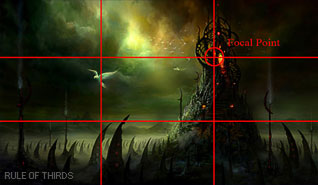Concept artist. Lots of people when they start this course, myself guilty included, wanted this to be their job. But not many people understand the job fully. They see the wonderful paintings that are produced by these artists and want to do the same without realising the process that goes on behind it. The finished products are only usually the things on display, without the mountains of research and planning being viewable to the public.
Concept art is used to show an idea through a visual medium. It needs to convey the right message to the viewer. This is especially difficult; a good piece of concept art shows for example a characters personality or the mood of the scene just by the way they have been painted. Subtle things such as pose, composition, lighting, ad colour help give an impression of what a person or place is like without even saying a word. Good art can tell a story to the viewer.
Behind the finished product, a concept artist has to put in a lot of planning. Skipping out this stage is fatal; lots of people (again guilty) start of a large scale painting without much thought. They just start painting then wonder why it doesn’t turn out right. A key thing to remember is that just because you have spent a lot of time on a painting doesn’t necessarily mean it will be good. This is why planning is important, as you need to sort out tricky things like composition to make a drawing work before you start painting in the detail. This is also why we do prep sketches in visual design, to get us used to planning out our work. The early stages in developing a painting are the most important.
Bringing up composition again, it’s very important to make it strong. Even the most interesting subject can look bland if the painting is composed poorly. In year one we did not spend that much time on composition, we pretty much drew what was in front of us. This year we need to produce drawings that are more dynamic. A good composition leads the eye to the points of interest in the painting. For example this site has lots of examples of compositional rules that work.
For example, the rules of thirds. This is where, if the drawing is split into thirds horizontally and vertically, where the lines meet are the points of interest in the painting. Placing the focal points on these intersections will make the painting more interesting. There are also other rules, but I find this one the easiest to use.
Getting this right is key for producing effective concept art. A concept artist will spend a good amount of time drawing lots of quick sketches to work this out before refining the image. Things such as colour and value are also important in a painting. The eye is usually drawn to the part of the image with the highest contrast. Colour is important for setting the mood of a piece and giving it atmosphere.
Time management is key for getting all these sketches done. For my own time management, I don’t think I’m too bad, although I do waste a bit of time on the internet or just generally faffing around. This year I am trying to invest a lot more time into my work, this year is really key in preparation for the third year.

No comments:
Post a Comment